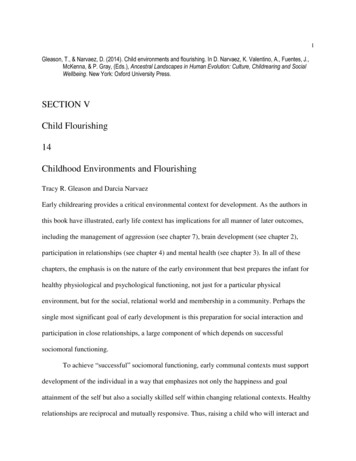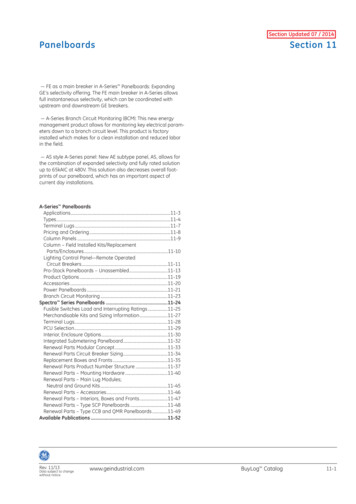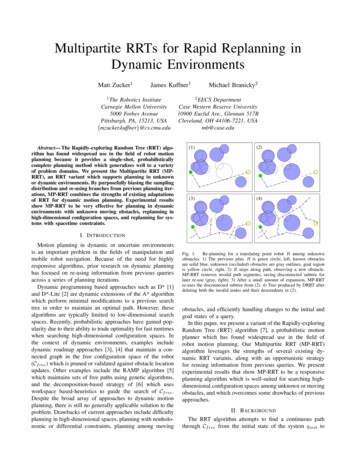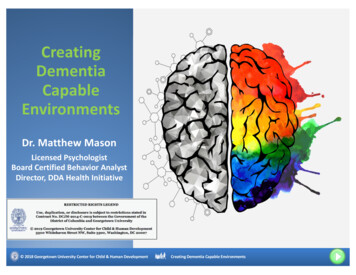
Transcription
1Gleason, T., & Narvaez, D. (2014). Child environments and flourishing. In D. Narvaez, K. Valentino, A., Fuentes, J.,McKenna, & P. Gray, (Eds.), Ancestral Landscapes in Human Evolution: Culture, Childrearing and SocialWellbeing. New York: Oxford University Press.SECTION VChild Flourishing14Childhood Environments and FlourishingTracy R. Gleason and Darcia NarvaezEarly childrearing provides a critical environmental context for development. As the authors inthis book have illustrated, early life context has implications for all manner of later outcomes,including the management of aggression (see chapter 7), brain development (see chapter 2),participation in relationships (see chapter 4) and mental health (see chapter 3). In all of thesechapters, the emphasis is on the nature of the early environment that best prepares the infant forhealthy physiological and psychological functioning, not just for a particular physicalenvironment, but for the social, relational world and membership in a community. Perhaps thesingle most significant goal of early development is this preparation for social interaction andparticipation in close relationships, a large component of which depends on successfulsociomoral functioning.To achieve “successful” sociomoral functioning, early communal contexts must supportdevelopment of the individual in a way that emphasizes not only the happiness and goalattainment of the self but also a socially skilled self within changing relational contexts. Healthyrelationships are reciprocal and mutually responsive. Thus, raising a child who will interact and
work with others rather than against them is a goal of development itself. A child who neverlearns, or is unable, to focus on the needs and feelings of others will likely have trouble with thefundamental tenets of dyadic and group dynamics, such as negotiation, cooperation,compromise, and empathy. Even if such skills are learned, the facility with which a childfunctions in a social context probably has a significant range, from necessary interactions thatpromote survival to myriad mutually fulfilling, long-term social relationships that promotethriving. In between these poles may lie our current state of parenting in the United States, inwhich many children—particularly those with resources—reach adulthood relatively unscathed,but the rates of depression, anxiety disorders, behavior problems, and toxic stress are at recordlevels, even among the middle class (American Academy of Child and Adolescent Psychiatry,2011a, 2011b; Shonkoff and Garner, 2012; U.S. Department of Health and Human ServicesSubstance Abuse and Mental Health Services Administration, 1999).According to neo-Darwinian evolutionary theory, organisms have three basic aims:survival, reproduction, and dispersal (Williams, 1966), and parenting typically facilitates them.As Halton (chapter 13) points out, our prolonged neoteny as a species and consequent plasticityallow for adaptation to a wide variety of environmental conditions that promote these outcomes.A prolonged childhood gives humans a level of resilience that allows some individuals to emergephysiologically and psychologically healthy despite significant risk factors in their earlyenvironments (Masten, Best, and Garmezy, 1990; Wright and Masten, 2005; Zolkoski andBullock, 2012). However, success in these situations is often identified, not as thriving, but asaverage functioning: showing a lack of symptoms or pathology and meeting developmentallyappropriate goals. Furthermore, often in studies of resilience, competence is measured in a singledomain, such as education (e.g., graduation from high school), rather than across domains (e.g.,
academic, behavioral, and emotional), thus providing an incomplete picture of individual wellbeing (Walsh, Dawson, and Mattingly, 2010). If, instead, success were defined as thriving oroptimal functioning in many, if not all, domains, the consequences of negative early lifeexperiences might be illustrated in sharp relief.Certainly developmental outcomes are influenced by a host of environmental factors ofwhich early childrearing is only one, and yet our ever-increasing understanding of the centralityof parenting contexts suggests that the goal of early childrearing should not simply be survival,or avoiding psychopathology and otherwise compromised functioning. As this volumedemonstrates, our knowledge of the connections between early childrearing contexts and lateroutcomes is significant and continually growing, and by attending to this knowledge we have thepotential to promote policies and programs that encourage not just survival, or resilience, butflourishing.FlourishingFlourishing among adults has been defined by positive psychologists as living “within an optimalrange of human functioning, one that connotes goodness, generativity, growth, and resilience”(Fredrickson and Losada, 2005, p. 678). Keyes (2002) has suggested that flourishing requires acombination of three types of well-being: emotional (positive emotion and life satisfaction),psychological (e.g., self-acceptance, autonomy, purpose), and social (e.g., social acceptance,actualization, contribution, integration). The work in this volume and the prior related one(Narvaez, Panksepp, Schore, and Gleason, 2013) suggests that physiological regulation isanother key aspect of flourishing that underlies the other types of well-being and might beheavily influenced by early social contexts. For the sake of measurement, in research these
factors are often conceptualized in terms of a ratio that has low levels of individual disease andpsychopathology but high levels of well-being and happiness (Keyes, 2002).Our concept of flourishing for children includes these same areas of physiological,emotional, psychological, and social health. We explicitly expand the notion of flourishing toinclude an emphasis on the sociomoral aspects of development, such as strengths in empathy andcooperation. In other words, flourishing is conceptualized with an emphasis on the moraldomain, such that it includes considering how actions affect others, taking into account the wellbeing of others, and including the community when making decisions and selecting actions.The emphasis on a social sense of well-being is an important distinction betweenparenting aimed at child survival, child resilience, or even adequate care, as well as the type ofparenting that fosters child flourishing within a community. Most childrearing contexts stress theneed to distinguish right and wrong and follow through with moral reasoning and empathicbehavior (Kochanska and Murray, 2000), and certainly such an orientation is important tonurture. Parenting that fosters flourishing, however, might be conceptualized as equally focusedon other aspects of morality identified by Rest (1984), such as recognizing moral issues inherentin situations (i.e., moral sensitivity), prioritizing moral values over other (e.g., personal,religious, patriotic) values (i.e., moral motivation), and the ability and ego strength to followthrough on moral decisions (i.e., moral character). In essence, childrearing contexts that promotechild flourishing are designed to encourage proactive, rather than reactive, forms of sociomoralbehavior. The childrearing contexts that support child flourishing support a high level ofautonomy, but within a strong socially connected community. Such robust functioning preparesthe individual for a fulfilling social life and provides the individual with capacities to fosterflourishing in others. In this way, flourishing is a communal affair (Aristotle, 1988). This
orientation is evident in some of the hunter-gatherer societies documented in this volume (e.g.,Endicott and Endicott).Parenting that supports child flourishing is also distinguishable from other developmentalcontexts in terms of its conceptualization of morality as encompassing all human beings, such asthe morality that characterizes individuals identified as moral exemplars. For example,individuals who hid Jews during World War II provide accounts of childhood upbringings inwhich care for all people was emphasized (Munroe, 2004; Oliner and Oliner, 1988). Fosteringthis perspective starts early and evolves with the changing capacities of the child. Initially, adultstreat the infant with tender empathy, generating a similar response in the infant (Schore, 1996;Siegel, 1999; Stern, 1999). Beyond infancy, empathic parents bring to children’s attention thefeelings and behaviors of specific others (Zahn-Waxler and Radke-Yarrow, 1990), followeddevelopmentally by an emphasis on how the child’s behavior affects others generally (Farrant,Devine, Maybery, and Fletcher, 2012). The key here is how “others” are identified. In thesomewhat isolated hunter-gatherer tribes described in this volume, relevant others might be thecommunity that gathers into small groups with fluid boundaries (see chapter 5). In the UnitedStates, national, religious, ethnic, or geographic boundaries might define the group of moralconcern. However, at an abstract level, “others” can theoretically be conceptualized as allhumans. This idea of humanity as the backdrop for sociomoral behavior can also includeconsideration of the needs of future generations, as is common among indigenous peoplesconcerned for “the seventh generation” into the future (Martin, 1999).Based on examination of hunter-gatherer lifestyles and attitudes, Narvaez (forthcoming)suggests that a focus on the individual or even a set of human beings is an inadequate framing forflourishing. In this view, biodiversity and entities in the natural environment must also be taken
into account. The community thus extends even beyond humanity. By this definition, small-bandhunter-gatherers flourished by living sustainably, with the welfare of the natural world in mind(Gowdy, 1998; Ingold, 1999). Parenting supportive of child flourishing might thereforeencourage consideration of sociomoral issues from as broad and abstract a perspective ascognitively possible at various points in development.Contexts for DevelopmentIn recent years, research has focused on childrearing environments variously described in theliterature as “average” (Baumrind, 1993), “good enough” (Hoghughi and Speight, 1998; Ryan,Martin, and Brooks-Gunn, 2006; Winnicott, 1957), and “positive” (von Suchodoletz,Trommsdorff, and Heikamp, 2011) or on the resilience of children growing up in dangerous,abusive, neglectful, or otherwise compromised environments. The latter, substandardenvironments are relatively easy to identify based on the presence of factors that clearlyundermine, if not threaten, children’s development. The features of adequate parenting are lesswell defined. The initial definition for “good enough” parenting provided by Winnicott (1957)centered on caregiving that was neither overtly problematic nor provided by someone with aclear psychiatric illness—rather low standards. More recent variations have somewhat higherbars, describing adequate parenting as including such components as unconditional love, clearboundaries for behavior, and facilitation of development primarily through the provision of asecure base for exploration (Hoghughi and Speight, 1998). They also may mention requirementssuch as a mentally healthy parent, with some knowledge of child development and acommitment to putting in the time required to care for the child (Mrazek, 2013).In general, the outcomes associated with care described as good enough are positive incomparison with care that is less than adequate. For example, work on attachment has clearly
established parental warmth, unconditional love, and the provision of a secure base as essentialto a whole host of positive self-regulatory, social, and emotional outcomes and the avoidance ofbehavior problems (e.g., Eisenberg, Zhou, Spinrad, Valiente, Fabes, and Liew, 2005; Kochanskaand Kim, 2012). Positive guidance, or developmentally appropriate limit-setting beyond infancy,has been associated with compliant behavior (Calkins, Smith, Gill, and Johnson, 1998), and ofcourse the importance of parental mental health and supportive parenting for positive childmental health outcomes is well established (e.g., DeMulder and Radke-Yarrow, 1991; Fisher,Rahman, Cabral de Mello, Chandra, and Herrman, 2010; Ge, Best, Conger, and Simons, 1996).Above all, sensitive and responsive care, a basic requirement for adequate childrearing, isheavily implicated in the development of successful stress regulation (Liu et al., 1997),regulation of arousal (Schore, 2001), appropriate social and emotional reactivity (Porges, 2007),and the development of conscience (Kochanska, 2002).The fact that the outcomes associated with average or adequate (good enough) parentingare positive raises two questions. How is a developmental context that promotes flourishingdifferent from parenting characterized as “good enough”? And if they are different styles, do thedevelopmental and cultural outcomes of these two environments differ significantly? The firstquestion can be addressed by the fact that the characteristics of flourishing defined above areembodied in many of the hunter-gatherer groups discussed in this volume, suggesting that theparenting practices they employ may foster the kind of prosocial, moral stance associated withflourishing (Narvaez, 2013).PROMOTING FLOURISHINGAmong the hunter-gatherer groups described in this book (chapters 4, 5, 6, and, 7) and elsewhere(e.g., Hewlett and Lamb, 2005; Narvaez, Panksepp, et al., 2013), childrearing is intense and
communal. For example, babies are held most of the time, and distress is mitigated quickly.Breastfeeding is infant initiated, shared among women, and lasts for several years. As they grow,children are rarely coerced but given ample time to play, and aggression is either ritualized ormet with strong social consequences. Children, and infants in particular, are cared for andconceptualized as the responsibility of the whole group, meaning that parents receive extensivesocial support and children have many resources from which to elicit caregiving. Children areintegrated into the life of the band at whatever level they are capable of participating, which, asFuentes (chapter 10) points out, may make them integral to the evolutionary adaptations of thespecies. In this context, children are not “parented” or “reared” so much as supported as theyactively develop as individuals within the community (Gray, 2013; see chapter 4).In this volume, Gray, Morelli et al., and Hewlett and Roulette (chapters 4, 6, and 8) allhighlight ways in which cultural values relate to parenting behaviors, such as encouraging playto promote egalitarianism, fostering sharing and cooperative exchange to create connections toothers and positive interpersonal relationships, and engaging in co-sleeping to nurtureinterdependence and foster family bonds. In each case, the behaviors include features of goodenough parenting, such as responsivity, secure attachment, mental health, and avoidance ofbehavior problems. But the caregiving associated with these flourishing cultures goes further toemphasize autonomy and respect for others, even infants and young children (see chapter 5). Thecritical importance of interpersonal harmony, a characteristic of the social section andcooperative family theory that Roughgarden and Song (chapter 9) show to be a better model offamily relations than the dominant competitive theory, centers the community in sociomoraldevelopment. In other words, success is not defined as the absence of antisocial behaviors but bythe presence of prosocial, cooperative actions and contributing, active membership within the
group. The distinction to be drawn is between the absence of the type of psychopathology welldescribed in chapters by Valentino, Comas, and Nuttall (chapter 11), and Bluhm and Lanius(chapter 12), a characteristic of good enough parenting, and the presence of optimality or wellbeing, characteristic of a developmental context that fosters flourishing. After all, a caregivingenvironment that is not characterized by disadvantage is not the same as one that is characterizedby thriving (Baumrind, 1993).OPTIMIZING DEVELOPMENTAL OUTCOMESIf a distinction can be made between adequate parenting and parenting that promotes flourishing,then the question becomes whether their developmental and cultural outcomes differsignificantly. Evidence is mounting that an orientation toward optimizing development with itscorresponding expectations leads beyond positive outcomes to actual flourishing. Aspects of theearly environment that are not usually discussed in the context of good enough or adequateparenting, such as breastfeeding, touch, alloparenting, and play, are associated with importantphysiological and psychological outcomes that set the stage for social group membership andflourishing (Narvaez, Panksepp, et al., 2013). In particular, the social context of the neonatalperiod is emerging as a critical time for psychological and physiological development that leadsto flourishing or otherwise (Shonkoff and Garner, 2012; Shonkoff and Phillips, 2000).Significant changes to and regulation of social functioning in adulthood have been documentedin relation to early brain and central nervous system development as a function of neuropeptides,steroids, and hormones (Cushing and Kramer, 2005). These physiological changes might meanthe difference between adult behavior that is, for example, reactive rather than proactive withregard to sociomoral demands. Furthermore, parenting practices like breastfeeding and touch
have been associated with physiological regulatory functions (Carter and Porges, 2013),suggesting they might be relevant in fostering flourishing.BreastfeedingBreastfeeding has multiple benefits. Although it is protective from disease and is accompaniedby increases in maternal focus on the infant in comparison with bottle feeding (Lavelli and Poli,1998; Newburg and Walker, 2007), it also has significant regulatory functions. Breastfeeding hasbeen implicated in regulation of the sleep–wake cycle, positive emotional tone, and brainfunctions such as reducing depression (Goldman, Goldblum, Garza, Nichols, and Smith, 1983).Moreover, in our own work (Narvaez, Cheng, Brooks, Wang, and Gleason, 2012; Narvaez,Gleason, Brooks, Wang, Lefever, and Cheng, in press; Narvaez, Wang, Gleason, Cheng,Lefever, and Deng, 2013), we have found connections between breastfeeding and aspects of selfregulation (e.g., inhibitory control) and sociomoral outcomes (e.g., empathy, conscience) inmaternal reports of 3-year-olds drawn from both the United States and China. Initiation ofbreastfeeding is also related to prosociality at 18 months and fewer behavior problems at 24months. All of these results remained significant even after we controlled for potentiallyinfluential factors, such as income, maternal age, and responsivity. Taken together, thesefindings suggest that either the process of breastfeeding or its components (thousands ofingredients, including all immunoglobulins, probiotics, amino acids needed for brain growth andfood for helpful bacteria)—likely both—might be directly related to children’s sociomoraloutcomes, or influential on factors that influence sociomoral development, such as physiologicalregulation.Touch
Copious positive touch in infancy is another behavior that may promote flourishing. Field andothers have provided extensive evidence of the benefits of gentle massage to the health anddevelopment of premature infants and neonates (see Field, Diego, and Hernandez-Reif, 2010, fora review), the consequences of which have been documented as long as 2 years later in thecognitive and to a lesser extent in the motor domain (Procianoy, Mendes, and Silveira, 2010).This positive impact of massage was observed even in comparison with simple skin-to-skincontact, which has also been demonstrated to be beneficial for infants’ cognitive, emotional, andphysiological regulation 6 months later (Feldman, Weller, Sirota, and Eidelman, 2002). Thisdocumentation of increased benefits of purposeful, positive touch over simply holding a babysuggests that further investigation of touch is warranted. Generally, touch associated withflourishing would be nearly constant in infancy, as practiced among hunter-gatherers, includingcarrying and co-sleeping. Both touch and co-sleeping have been associated with regulatoryprocesses, possibly through effects on the vagal system and reduction of stress hormones (Carterand Porges, 2013; Field et al., 2010; McKenna et al., 1994). If such effects are cumulative, theyare likely to mediate a distinction between adequate parenting and contexts that fosterflourishing. Our work supports such a distinction, in that in two cultures (United States andChina), we found that maternal reports of positive touch both in terms of behavior and attitudeswere positively correlated with their reports of greater empathy and inhibitory control in their 3year-olds (Narvaez, Wang, Cheng, and Gleason, 2013). These results remained significant evenafter controlling for maternal education and income, as well as the responsive care associatedwith good enough parenting.Alloparenting, Social Support, and Cooperative Childrearing
The idea that alloparenting supports sociomoral development and consequent flourishing issimple: multiple responsive caregivers allow for not only shared responsivity to the child’s needsbut also greater support for the child’s primary caregiver. Multiple caregivers are associated witha higher standard of living and more effective parenting than families with single parents, thuslowering the child’s risk for cognitive, social, and emotional problems (Amato, 2005).Traumatized mothers will also have difficulty providing the responsive care their children need(see chapter 12). Such trauma indicates a breakdown in social support at some point in her life.Relatedly, mothers who perceive themselves as living within a supportive social context aremore likely to have children with better social skills and fewer behavior problems than thosewho do not. Presence of multiple adults may well provide good opportunities for the child toengage in beneficial social interactions (Koverola, Papas, Pitts, Murtaugh, Black, and Dubowitz,2005). Social support is directly related to parenting in that higher levels of parental socialsupport are correlated with less parenting stress and less ineffective parenting. Social support isalso negatively correlated with parents’ reports of children’s behavior problems (McConnell,Breitkreuz, and Savage, 2011).Although work on adequate parenting and children’s resilience under adversecircumstances often mentions the importance of nonparental adults in children’s lives (e.g.,Masten et al., 1990), the notion of alloparenting as a critical component of childrearing is nottypically emphasized. We have found (Gleason, Narvaez, Cheng, Wang, and Brooks, 2013) thatmother’s attitudes toward alloparenting cohere with attitudes toward responsivity, touch, andplay into a singular construct of nurturing parenting. This cohesion emphasizes the importance ofpositive attitudes toward alloparenting as an important component of the social environment thatmight predict children’s sociomoral outcomes and flourishing.
PlayIn contrast to breastfeeding, touch, and alloparenting, whose effects are arguably felt mostdistinctly if they are missing in infancy, play is central most notably in the preschool- andschool-aged years (Rubin, Fein, and Vandenberg, 1983). In the context of child flourishing, playis critical for two functions: (1) the development of physiological regulation, particularly withrespect to emotion in social situations; and (2) exposure to and experience in reciprocal socialrelationships with peers and friends—individuals who, in contrast to adults, are similar to thechild in competence and power.Play is universal and takes many forms, from solitary to fantasy based to the physicalinteractions typical of rough-and-tumble (R&T) play. Both fantasy and R&T play have beenassociated with the successful development of emotion regulation in early to middle childhood(Lillard, Lerner, Hopkins, Dore, Smith, and Palmquist, 2013; Pellegrini and Smith, 1998). Theseforms of play involve intricate interactions with others that require both parties to understand thatthe nature of the behaviors is playful. Social pretend play, particularly if involving frightening orangry themes, requires appropriate modulation of emotion and arousal (Galyer and Evans,2001)—as does successful involvement in R&T (Peterson and Flanders, 2005). Although littleresearch has examined the effects on children denied these forms of play over long periods, shortdeprivation periods are followed by longer and more intense engagement in play and areassociated with compromises in attention (Pellegrini and Smith, 1998).Fry (chapter 7) has described typical R&T play in both humans and other primates andhas made the argument for consideration of this type of play as a way of learning restraint inaggressive interactions with others. Similarly, Gray (chapter 8) has discussed play generally as away of developing and reinforcing egalitarian interactions within hunter-gatherer communities.
Social pretend play has also been discussed in the developmental literature as a forum forpracticing important social skills such as negotiation, compromise, and cooperation (Black,1992; Doyle and Connolly, 1989; Howe, Petrakos, and Rinaldi, 1998). Perhaps more important,play in childhood typically involves peers, a critical context for social development, and is animportant basis for friendship (Hartup, 1992). Because successful creation of close, egalitarian,social relationships is a hallmark of flourishing, provision of opportunities for play in order todevelop such relationships is a critical component of the nurturing caregiving environment.ConclusionSocial relationships are the cornerstone of human development. From the moment of existence,each individual is nested in a network of ties to others that both create and modulate a whole hostof biological and behavioral systems (Reis, Collins, and Berscheid, 2000). Although survivalafter childhood is possible without a complex network of social relationships, both physical andpsychological functioning are seriously compromised in those who are socially isolated(Berscheid and Regan, 2005). What is more, even a close connection to a single adult is typicallyinsufficient for optimal development (Amato, 2005). For children, particularly infants,entrenchment in a social context is a critical step toward survival, but flourishing requires acommunity. As the chapters in this volume illustrate, the quality of the nurturing environment iskey to whether children endure, adapt to, or actively benefit from it. Flourishing must thereforebe defined not just in terms of the successful formation and maintenance of close ties to others,but also in terms of the child’s resultant sociomoral orientation toward others and active, positiveparticipation in the community.Although warm, sensitive, and responsive care is the foundation of sociomoral behavior(Kochanska, 2002; Kochanska and Kim, 2012; Kochanska and Murray, 2000), consideration of
other parenting and communal practices, such as breastfeeding, touch, alloparenting, and playmight illustrate the difference between adaptive and optimal development. These behaviors,common to the small-band hunter-gatherers, are associated with important physiological andpsychological outcomes that significantly raise the likelihood of a child interacting with others inprosocial ways. Most important, a community of individuals who receive the kind of parentingthat is associated with sociomoral flourishing is more likely to create a community in which joyand well-being are fostered by and for all.ReferencesAmato, P. (2005). The impact of family formation change on the cognitive, social, and emotionalwell-being of the next generation. The Future of Children, 15, 75–96.American Academy of Child and Adolescent Psychiatry. (2011a). Stress in America.Washington, DC: American Psychological Association.American Academy of Child and Adolescent Psychiatry (2011b). Campaign for America’s kids.Retrieved January 19, 2011, from http://www.campaignforamericaskids.org.Aristotle. (1988). Nicomachean ethics (W. D. Ross, Trans.). London: Oxford University Press.Baumrind, D. (1993). The average expectable environment is not good enough: A response toScarr. Child Development, 64(5), 1299–1317.Berscheid, E., & Regan, P. (2005). The psychology of interpersonal relationships. Upper SaddleRiver, NJ: Pearson Prentice Hall.Black, B. (1992). Negotiating social pretend play: Communication differences related to socialstatus and sex. Merrill-Palmer Quarterly, 38(2), 212–232.
Calkins, S. D., Smith, C. L., Gill, K. L., & Johnson, M. C. (1998). Maternal interactive styleacross contexts: Relations to emotional, behavioral, and physiological regulation duringtoddlerhood. Social Development, 7(3), 350–369.Carter, C. S., & Porges, S. W. (2013). Neurobiology and the evolution of mammalian socialbehavior. In D. Narvaez, J. Panksepp, A. Schore, & T. Gleason (Eds.), Evolution, earlyexperience and human development: From research to practice and policy (pp. 132–151). New York: Oxford University Press.Cushing, B. S., & Kramer, K. M. (2005). Mechanisms underlying epigenetic effects of earlysocial experience: The role of neuropeptides and steroids. Neuroscience andBiobehavioral Reviews, 29(7), 1089–1105.DeMulder, E. K., & Radke-Yarrow, M. (1991). Attachment with affectively ill and well mothers:Concurrent behavioral correlates. Development and Psychopathology, 3(3), 227–242.Doyle, A.-B., & Connolly, J. (1989). Negotiation and enactment in social pretend play:Relations to social acceptance and social cognition. E
bars, describing adequate parenting as including such components as unconditional love, clear boundaries for behavior, and facilitation of development primarily through the provision of a











